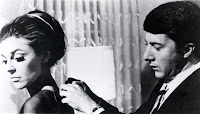 A recent blog post on EW.com argued that the greatest year for movies ever was 1984. Is this something of an overstatement? No doubt 1984 was a very good year for movies. After all, it was the year that gave birth to such masterpieces as “Amadeus,” “Once Upon a Time in America,” and “Blood Simple” as well as such popular classics as “Footloose,” “The Natural,” “Ghostbusters,” and “Indiana Jones and the Temple of Doom.”
A recent blog post on EW.com argued that the greatest year for movies ever was 1984. Is this something of an overstatement? No doubt 1984 was a very good year for movies. After all, it was the year that gave birth to such masterpieces as “Amadeus,” “Once Upon a Time in America,” and “Blood Simple” as well as such popular classics as “Footloose,” “The Natural,” “Ghostbusters,” and “Indiana Jones and the Temple of Doom.”
Some great movies, no doubt, but does this really constitute as the greatest year for movies ever? Here now, I would like to explore the five most important (not just the best) years in cinematic history:
1927- The year modern cinema was born. “The Jazz Singer” became the first feature-length “talkie” ever. “Jazz Singer” allowed the existence of such timeless snippets of dialogue as “Here’s looking at you kid,” and “I’ll make him an offer he can’t refuse”–however it also allowed for years of Michael Bay films and endless amounts of fart jokes.
1939- The second Dorothy exited black and white Kansas and entered color-filled Oz, audiences knew film would never be the same. However, “The Wizard of Oz” was not the only great achievement of 1939. Films like “Gone with the Wind,” “Stagecoach,” “Mr. Smith Goes to Washington,” and “Wuthering Heights” would become part of film fanatics’ basic vocabulary, and add to the year that most historians call “the miracle year” for movies.
1967- Outside the theater, upheaval over the Vietnam War as well as the beginning of the Sexual Revolution were causing America to lose its innocence. That anger and newfound maturity soon made its way into the movies. “The Graduate” and “Bonnie and Clyde” showed the erasing of decades of Hays Code oppression and a new exploration of violence and sex that had never before been seen in film. However this was only the beginning of a revolution that took full bloom two years later.
1969- The revolution was now in full bloom. In this year, “Midnight Cowboy” became the first and only X-rated film to ever take home the Best Picture prize. “Easy Rider” showed the true life of the counterculture with no restraints. Filmmakers were no longer afraid; they were ready to head to uncharted waters in the years ahead. Perhaps the most famous line from “The Wild Bunch” best sums up 1969: “it ain’t like it used to be, but it’ll do.”
1999- 30 years later, a new revolution was born. “The Blair Witch Project,” although arguable in its quality (see my review here), proved that any movie, no matter how small, was capable of making a massive profit. Could this truly have been the movie that gave studio executives more faith in the independent film? But ’99 was not all about “Blair Witch.” It also gave birth to darker, more out-of-the-box views of typical American life such as “American Beauty,” “Election,” and “Magnolia.” It also gave us the first major film about the First Gulf War (“Three Kings”) and a comedy about the inside of John Malkovich’s head (“Being John Malkovich”). The real question now is, where will the revolution of ’99 take us from here?
